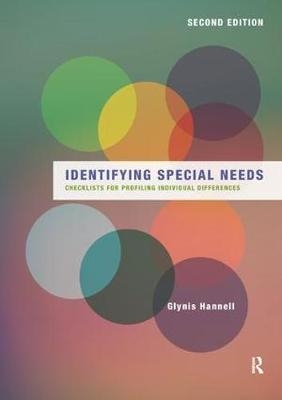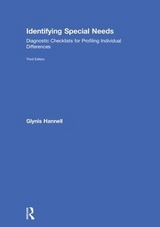
Identifying Special Needs
Checklists for profiling individual differences
2017
|
2nd New edition
Routledge (Verlag)
978-1-138-43429-5 (ISBN)
Routledge (Verlag)
978-1-138-43429-5 (ISBN)
- Titel erscheint in neuer Auflage
- Artikel merken
Zu diesem Artikel existiert eine Nachauflage
Drawing from her experience as an educational psychologist, and special education teacher, Glynis Hannell offers guidelines to help teachers quickly recognize and categorize the specific characteristics of developmental disorders, autism spectrum disorders, emotional-behavioural disorders, specific learning disorders, sensory impairments and other forms of special need.
The practical checklists and resources in this fully revised new edition help both classroom and specialist teachers to:
Screen any student for possible special needs
Understand the causes and characteristics of various types of special needs
Request and prepare for an intervention or IEP team meeting
Link classroom observations to diagnostic criteria used by specialists
Create accurate and comprehensive profiles for individual students
Record each student's unique pattern of development within a special needs �label�
Quickly record important information and avoid writing time-consuming reports
Coordinate information from several teachers or professionals
Monitor progress and track significant changes over time
Involve parents in observing and discussing their child's pattern of strengths and challenges
Plan effective, inclusive intervention in the classroom setting
Follow up with recommended further reading, websites and professional references
Recognising special needs and identifying each student's unique profile of positive attributes and difficulties enables teachers and other educational professionals to ensure that all their students receive the support they need to succeed.
The practical checklists and resources in this fully revised new edition help both classroom and specialist teachers to:
Screen any student for possible special needs
Understand the causes and characteristics of various types of special needs
Request and prepare for an intervention or IEP team meeting
Link classroom observations to diagnostic criteria used by specialists
Create accurate and comprehensive profiles for individual students
Record each student's unique pattern of development within a special needs �label�
Quickly record important information and avoid writing time-consuming reports
Coordinate information from several teachers or professionals
Monitor progress and track significant changes over time
Involve parents in observing and discussing their child's pattern of strengths and challenges
Plan effective, inclusive intervention in the classroom setting
Follow up with recommended further reading, websites and professional references
Recognising special needs and identifying each student's unique profile of positive attributes and difficulties enables teachers and other educational professionals to ensure that all their students receive the support they need to succeed.
Glynis Hannell is an educational consultant and award-winning author.
1. Introduction 2. Developmental disorders 3. Autism Spectrum Disorder 4. Specific learning disorders 5. Emotional and behavioural disorders 6. Sensory impairments 7. Supplementary checklists 8. Charts to guide selection of checklists
| Erscheinungsdatum | 07.10.2017 |
|---|---|
| Verlagsort | London |
| Sprache | englisch |
| Maße | 210 x 297 mm |
| Gewicht | 794 g |
| Themenwelt | Sozialwissenschaften ► Pädagogik ► Sonder-, Heil- und Förderpädagogik |
| ISBN-10 | 1-138-43429-9 / 1138434299 |
| ISBN-13 | 978-1-138-43429-5 / 9781138434295 |
| Zustand | Neuware |
| Informationen gemäß Produktsicherheitsverordnung (GPSR) | |
| Haben Sie eine Frage zum Produkt? |
Mehr entdecken
aus dem Bereich
aus dem Bereich
was Eltern und Pädagogen wissen müssen
Buch | Softcover (2023)
Kohlhammer (Verlag)
CHF 47,60
das Struktur-Lege-Verfahren als Kompass
Buch | Softcover (2024)
modernes lernen (Verlag)
CHF 33,50



